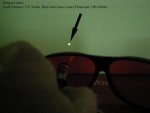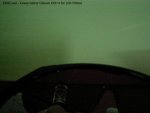Arayan
0
- Joined
- Oct 26, 2009
- Messages
- 1,746
- Points
- 48
I did a preliminary test on two safety goggles for green lasers (532 nm), and I found something that I did not expect:
I blocked a green beam (<5 mW Laserglow Anser) with goggles from Dragonlaser and from Elitelasers. Those from DL (OD> 4 for 190-533nm) let through a clearly visible green dot (at various distances), while those from EL (OD> 4 for 200-540nm) totally block the beam (at various distances).
So be careful to use those from DL for high power lasers!!
I blocked a green beam (<5 mW Laserglow Anser) with goggles from Dragonlaser and from Elitelasers. Those from DL (OD> 4 for 190-533nm) let through a clearly visible green dot (at various distances), while those from EL (OD> 4 for 200-540nm) totally block the beam (at various distances).
So be careful to use those from DL for high power lasers!!







